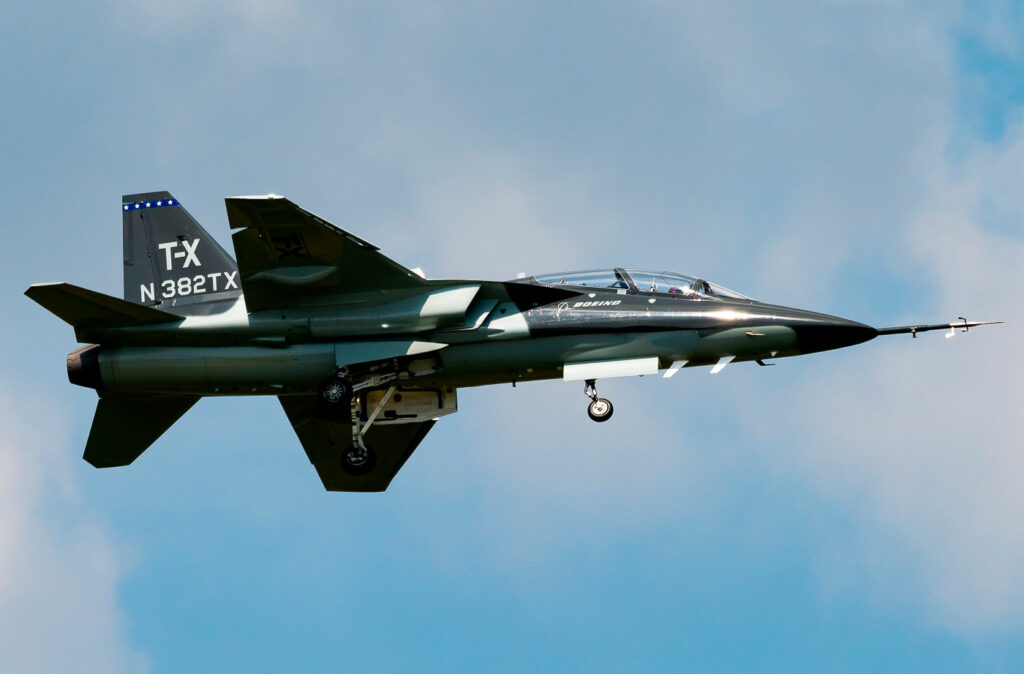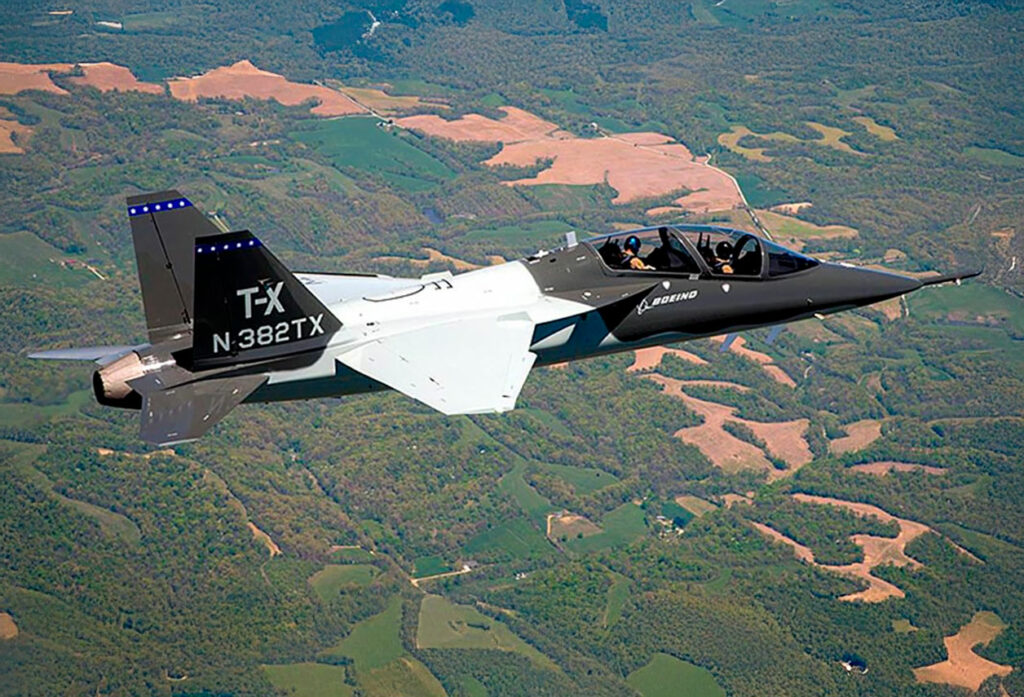The Boeing-Saab T-7 Red Hawk is a U.S. Air Force advanced jet trainer with a General Electric F404 engine, digital fly-by-wire controls, and modern avionics.
The Boeing-Saab T-7 Red Hawk is an advanced jet trainer developed for the U.S. Air Force to replace the aging T-38 Talon. Designed collaboratively by Boeing and Saab, the T-7 features a single General Electric F404 afterburning turbofan engine, producing 11,000 pounds-force (49 kN) of thrust dry and 17,200 pounds-force (76 kN) with afterburner. The aircraft measures 46 feet (14 meters) in length with a wingspan of 30.6 feet (9.3 meters). It incorporates digital fly-by-wire controls, a fully digital glass cockpit, and stadium seating to enhance instructor visibility. The T-7A is designed to meet modern training requirements, providing flexibility to evolve with changing technologies and missions.
History of the Development of the Boeing-Saab T-7 Red Hawk (eT-7A)
In the early 2000s, the U.S. Air Force recognized the need to replace its aging fleet of T-38 Talon trainers, which had been in service since the 1960s. The T-38, while revolutionary at its inception, was becoming increasingly inadequate for preparing pilots to operate modern fourth- and fifth-generation fighter aircraft. The advancing complexity of aircraft systems and the evolving nature of aerial combat necessitated a new trainer with capabilities aligned to contemporary and future operational demands.
In 2003, the Air Education and Training Command (AETC) began formulating requirements for a new advanced jet trainer under the T-X program. The objective was to develop an aircraft that could provide comprehensive training for pilots transitioning to advanced fighters like the F-22 Raptor and the F-35 Lightning II. Key requirements included modern avionics, high maneuverability, and systems that could simulate advanced combat scenarios.
Boeing, in partnership with Swedish aerospace company Saab, responded to this need by developing a purpose-built trainer. On December 6, 2013, Boeing and Saab announced their collaboration to compete for the T-X program. The partnership aimed to leverage Boeing’s experience in military aircraft production and Saab’s expertise in agile development and cost-effective manufacturing.
The development process was notably rapid and efficient. Utilizing advanced digital design and manufacturing techniques, the team moved from concept to first flight in just 36 months. The first prototype was unveiled on September 13, 2016, and it took to the skies for its maiden flight on December 20, 2016. This swift progression was achieved through model-based engineering and three-dimensional design tools, which improved engineering quality by 75% and reduced assembly hours by 80% compared to traditional methods.
In September 2018, the U.S. Air Force selected the Boeing-Saab design as the winner of the T-X program, awarding a contract valued at up to $9.2 billion for 351 aircraft, 46 simulators, and associated ground equipment. The aircraft was subsequently designated as the T-7A Red Hawk, honoring the Tuskegee Airmen of World War II, who were known for the distinctive red tails of their aircraft.
The T-7A’s development reflects a strategic response to the evolving requirements of military aviation training. By integrating modern technologies and adopting a flexible design approach, the program aims to produce an aircraft capable of preparing pilots for the complexities of current and future aerial combat.

Design of the Boeing-Saab T-7 Red Hawk (eT-7A)
The Boeing-Saab T-7 Red Hawk features a design that emphasizes performance, safety, and adaptability. The aircraft measures 46 feet (14 meters) in length and has a wingspan of 30.6 feet (9.3 meters). Its design incorporates a single-engine configuration, utilizing the General Electric F404 afterburning turbofan engine, which provides 11,000 pounds-force (49 kN) of thrust dry and 17,200 pounds-force (76 kN) with afterburner.
One of the notable design features is the digital fly-by-wire control system, which enhances handling characteristics and allows for precise control inputs. The fully digital glass cockpit provides pilots with advanced avionics displays, improving situational awareness and facilitating the management of complex training scenarios. The “stadium seating” arrangement in the tandem cockpit positions the instructor slightly above the student, offering improved visibility and communication during training flights.
The T-7A’s modular design allows for ease of maintenance and upgrades. Systems are designed with accessibility in mind, reducing downtime and lifecycle costs. The open architecture software framework enables the integration of new technologies and systems as they become available, ensuring the aircraft remains relevant in the face of evolving training requirements.
The aircraft’s design also prioritizes safety. The T-7A is equipped with the latest ACES 5 ejection seats, providing enhanced protection for pilots in emergency situations. Additionally, the aircraft’s structure is engineered to meet or exceed current safety standards, incorporating features such as energy-absorbing landing gear and crashworthy fuel systems.
In terms of aerodynamics, the T-7A features leading-edge root extensions and slats, which enhance its low-speed handling characteristics. This design choice allows for better control during critical phases of flight, such as takeoff and landing, and contributes to the overall agility of the aircraft.
The T-7A’s design reflects a focus on creating a versatile and future-proof training platform. By integrating advanced technologies, emphasizing safety, and allowing for adaptability, the aircraft is well-suited to prepare pilots for the demands of modern aerial combat.
Performance of the Boeing-Saab T-7 Red Hawk (eT-7A)
The Boeing-Saab T-7 Red Hawk is powered by a single General Electric F404-GE-103 afterburning turbofan engine. This engine produces 11,000 pounds-force (49 kN) of thrust in dry conditions and up to 17,200 pounds-force (76 kN) with afterburner.
The aircraft has a maximum speed of Mach 0.975, allowing it to operate effectively in various training scenarios. Its service ceiling reaches 50,000 feet (15,240 meters), providing a broad operational envelope for high-altitude training missions.
With a range of approximately 990 nautical miles (1,140 miles or 1,830 kilometers), the T-7A can conduct extended training sorties without the need for frequent refueling. This range is adequate for most training missions, allowing for comprehensive in-flight instruction and maneuvering exercises.
The aircraft’s empty weight is approximately 18,000 pounds (8,165 kilograms), with a maximum takeoff weight around 22,000 pounds (9,979 kilograms). This weight profile, combined with its thrust capabilities, results in a favorable thrust-to-weight ratio, contributing to its agility and performance during training operations.
When compared to its predecessor, the T-38 Talon, the T-7A offers significant advancements. The T-38, introduced in the 1960s, has a maximum speed of Mach 1.3 and a service ceiling of 50,000 feet. However, it lacks modern avionics and the advanced flight control systems present in the T-7A. The T-7A’s digital fly-by-wire system and glass cockpit provide a more relevant training environment for pilots transitioning to contemporary fighter aircraft.
In comparison to other modern trainer aircraft, such as the KAI T-50 Golden Eagle, the T-7A holds its own. The T-50 features a maximum speed of Mach 1.5 and a service ceiling of 55,000 feet, offering higher performance metrics. However, the T-7A’s design emphasizes cost-effectiveness and ease of maintenance, with an open architecture that allows for future upgrades, potentially providing a more adaptable platform over time.
Overall, the T-7A Red Hawk’s performance characteristics align well with its intended role as an advanced jet trainer. Its balance of speed, agility, and modern systems integration ensures that it can effectively prepare pilots for the demands of current and future combat aircraft.
Variants of the Boeing-Saab T-7 Red Hawk (eT-7A)
As of now, the primary variant of the Boeing-Saab T-7 is the T-7A Red Hawk, developed specifically for the U.S. Air Force’s advanced pilot training program. This variant is designed to replace the aging T-38 Talon fleet and is tailored to meet the USAF’s specific training requirements.
While there are no officially announced variants beyond the T-7A, the aircraft’s modular design and open architecture allow for potential adaptations. This flexibility could enable the development of specialized versions in the future, such as light attack or aggressor aircraft, depending on emerging needs and customer interest.
The collaboration between Boeing and Saab also opens possibilities for international variants. Different air forces may require customized configurations to align with their specific training doctrines and operational environments. The T-7’s adaptable design facilitates such modifications, making it a viable candidate for various global training programs.
In summary, while the T-7A Red Hawk is currently the sole variant in production, the aircraft’s design philosophy supports the potential development of multiple variants to meet diverse military aviation needs in the future.

Military Use and Combat of the Boeing-Saab T-7 Red Hawk (eT-7A)
The Boeing-Saab T-7 Red Hawk (eT-7A) is primarily designed as an advanced jet trainer for the U.S. Air Force, intended to replace the aging T-38 Talon fleet. As such, it is not equipped with armament and is not intended for combat operations. Its primary role is to prepare pilots for transition to frontline fighter aircraft by providing a training environment that closely simulates modern combat aircraft systems and performance.
The T-7A’s design focuses on providing a versatile and effective training platform. It features advanced avionics, a digital fly-by-wire control system, and a fully digital glass cockpit, all aimed at replicating the experience of operating modern fighter jets. This ensures that pilots receive comprehensive training that prepares them for the complexities of contemporary aerial combat.
While the T-7A itself is not intended for combat, its development reflects a broader trend in military aviation towards integrating advanced training systems that can better prepare pilots for the demands of modern warfare. By providing a more realistic and adaptable training environment, the T-7A aims to enhance the proficiency and readiness of future fighter and bomber pilots.
The Boeing-Saab T-7 Red Hawk (eT-7A) represents a significant advancement in military pilot training. Its modern design, incorporating advanced avionics, digital fly-by-wire controls, and a fully digital glass cockpit, provides a training environment that closely mirrors that of current frontline fighter aircraft. The aircraft’s performance characteristics, including its thrust-to-weight ratio and aerodynamic features, ensure that it can effectively simulate the flight dynamics of modern combat jets. While not intended for combat, the T-7A’s role in preparing pilots for the complexities of modern aerial warfare is paramount. Its adaptability and advanced systems integration make it a cornerstone of future U.S. Air Force pilot training programs.
Back to the Trainers section.